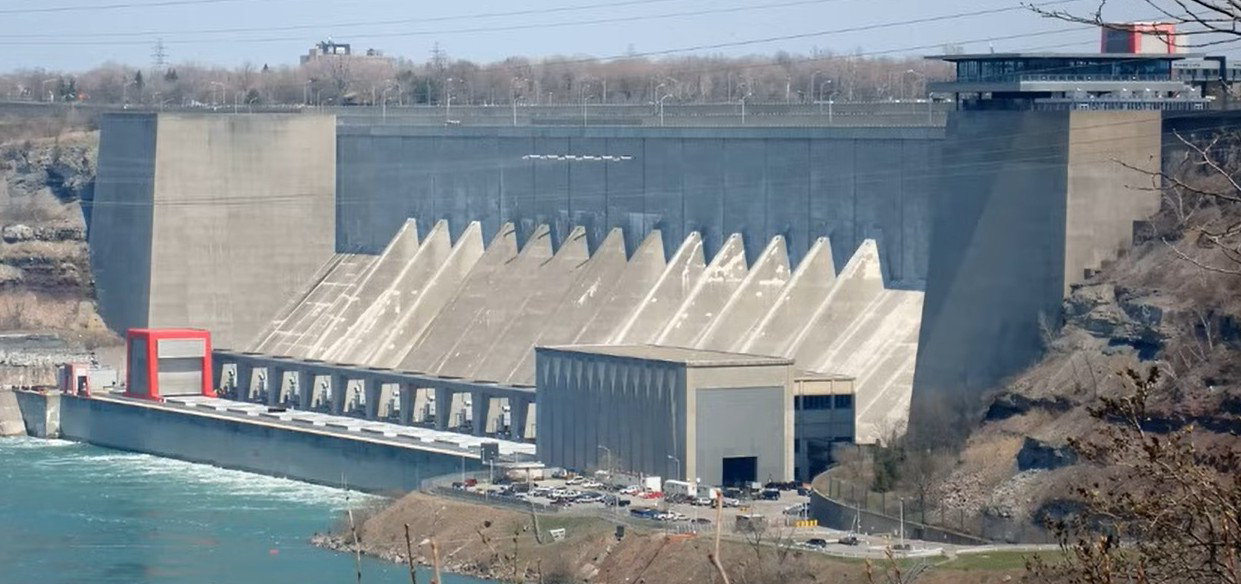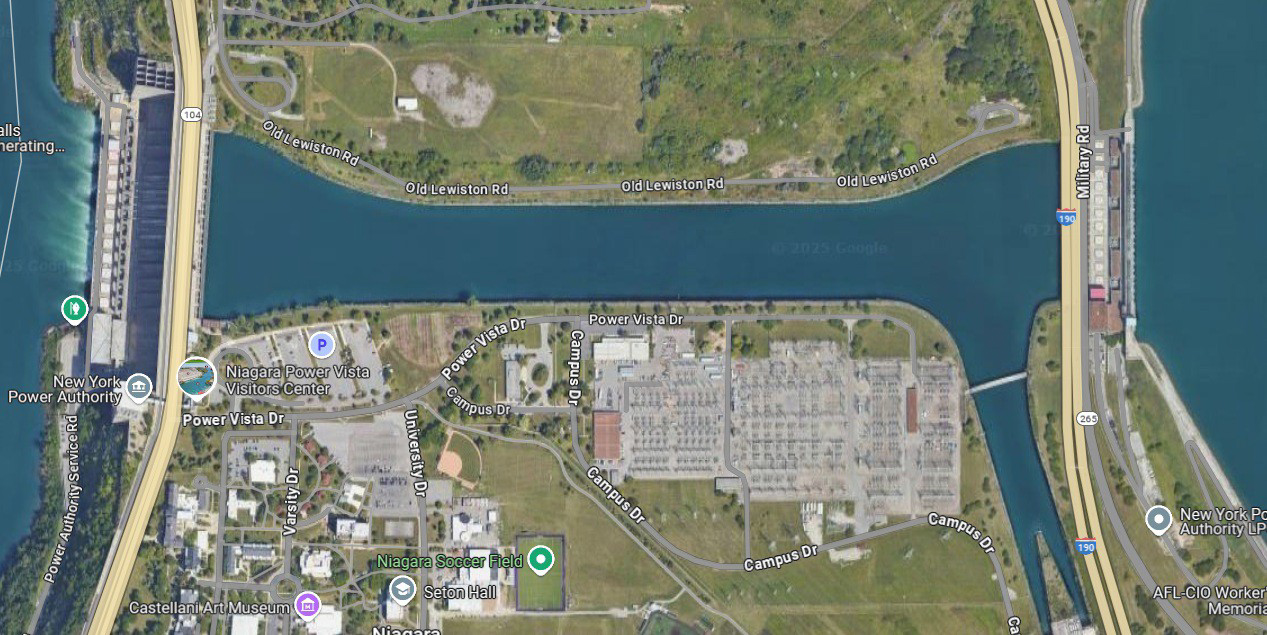Robert Moses
The Robert Moses Power Plant and associated construction occurred during my high school years. With a father who lived and breathed hydro-electric plants, we carefully followed the entire process. The population of the city of Niagara Falls swelled with the influx of construction workers and the disruption to city life was beyond description. When finished, we had new parkways, a new international bridge, Interstate I-190 connecting the U.S. and Canada and several other improvements.

Robert Moses Power Plant 1961 - present
The main power plant consists of 13 generators, with one usually undergoing maintenance. The number of generators running at any time depends on the demand and the availability of water. The management of water resources, per an international treaty, is detailed in a companion article. Since it is much easier to add or remove hydro-electric resources than other resources, the number of generators in operation tends to increase in the afternoon as the demand increases and decrease later at night. It underwent refurbishment and modernization in 2006.
The facility hosts the Power Vista at the upper-right of the photo. The Power Vista contains a great display of how the facility operates and may historical photos of the older power plants at Niagara Falls. In addition it contains one floor of dedicated to children. A spare turbine is on display outside the entrance. Overall, a visit to the Power Vista is highly recommended and it is free of charge.
In addition to the main generating plant, the Lewiston Pump-Generating Station’s 12 pump-generators, are used to store water during periods of excess water and electricity, typically through the night. As demand increases, the pumps become generators, returning water to the forebay, when it can then be used by he generators in the main generating plant, typically from the afternoon through the evening. The Lewiston Pump-Generating Station is the only true dam in the area. The reservoir behind it was constructed from rock excavated during the construction. It underwent modernization in 2021.

Robert Moses Power Plant (left), Forebay (center), Lewiston Pump-Generating Station (right) Water entrance (lower-right), Reservoir (far right)
Location
When talking to tourists, a frequently asked question is: “Why are the modern generating plants located so far down river from the falls?” The answer has do with maximizing the efficiency. The amount of power generated per unit of water is directly proportional to the elevation differential between the water source at the top and the turbine at the bottom, called “head.”
- The John Dean Adams plant was built up-river from the falls and sacrificed 80 feet of elevation to obtain a proper slope for the long discharge tunnel. Therefore, it had a head of only 140 feet.
- The generating stations nearer to the falls either had no discharge tunnel or a much shorter tunnel. They had heads of 200 to 210 feet.
- Since the lower Niagara River has rapids from the falls to in front of Niagara University and the Devil's Hole, this is another 80 feet of elevation that can be gained by building the generating plant past the end of the rapids. This results in a head of 315 feet.
- Finally, the generating plant must be before the Niagara Escarpment, where the land drops off significantly. Therefore, the maximum head can be obtained only along a short section of the Niagara River, after the rapids and before the escarpment.
I remember my Father taking me to the edge of the gorge, before the Schoellkopf collapse, and saying’
“This is where we plan to build the new power plant.” The location was next to Niagara University,
opposite Sir Adam Beck, and the location where the Robert Moses plant stands today. He was correct about the location, but not the “we.” Instead of being built by his employer, Niagara Mohawk, it was built by the State of New York for two main reasons:
- First, it was decided that a strategic resource of this importance should be publicly owned, rather than owned by a private, for profit corporation. Canada made this determination long ago, when Sir Adam Beck #1 was built.
- Second, the magnitude of the power project itself and all of the related side projects, far exceeded the ability of any private company. The side projects included highway construction, using excavated rock from the power project, obtaining Native American land for the reservoir just to name a few.
The 1,900 acre reservoir can store 22 billion gallons of water. The U.S. Supreme Court awarded the New York Power Authority the right to take 550 acres of the Tuscarora Reservation for the price of $1,500 per acre. (Prior to the court’s decision, I remember Chief Mad Bear defending their land with a shotgun, threatening to shoot the first bulldozer operator to cross onto the Reservation.)
Water the power plant is drawn from the upper Niagara River above the falls and carried across the city by two buried conduits to the forebay. The two lift gates (essentially gate valves) can be seen along the scenic Robert Moses Parkway.
My Private Tour
In the Spring of 1962, at the age of 17, my Father used his connections to obtain a private tour into the inner workings of the new Robert Moses Power Plant.
I remember standing down at the bottom, between buildings, each of which housed a single generator. The double steel doors of one were rattling and I could hear the hum from the transformer just outside. It was running! (The generators each produce 2,000,000 Watts of electricity at a relatively low voltage and huge current. The conductors exiting the generator are the diameter of dinner plates. Therefore, the transformer increases the voltage and reduces the current to levels suitable for transmission to the switch yard via oil-cooled cables.)
The doors of the next generator were quiet, allowing us to turn on the lights and enter the generator. I have lived in smaller spaces and a small family could live in the pie-shaped rooms created by the arms that supported to rotor, which would serve as the ceiling, Around the outside, the height allowed an adult to walk completely around. Looking upward, I could see the narrow gap between the field windings of the rotor and the main output windings of the stator.
Next, we went into a room between the turbine below and the generator above. The floor was a circular metal grate, much like a fire escape. The volute casing of the turbine and the mechanism that controls the wicket gates was just below my feet. The 28 foot penstock entered the volute casing in the corner of the room. The 5 foot diameter shaft connecting the turbine to the generator was withing inches. I remember this room being deathly silent and peaceful. Then I looked at the shaft. It was spinning, indicating that this machine was running. I still marvel at the silence of a huge amount of potential energy existing 300 feet above, a huge amount of kinetic energy entering the turbine, the conversion to 240,000 Hp of mechanical energy just below my feet, and the conversion to 2,000,000 Watts of electricity just above my head.
There were things that I would have liked to see, but did not.
- One was the inside of the giant, movable gantry crane that can pull the entire rotating parts of the generator out for maintenance. Entering that space would be too dangerous.
- We did not enter the control room for security reasons, although I have seen other control rooms. The control room is probably computerized after the recent upgrade and would be very different that I would have seen in 1962.
- I would have liked to see what is used for the trust bearing that supports the enormous weight of the rotating parts; turbine, shaft, and rotor. I assume that the thrust bearing was at the bottom of the turbine and probably used high pressure water, rather than oil, between the bearing plates.

